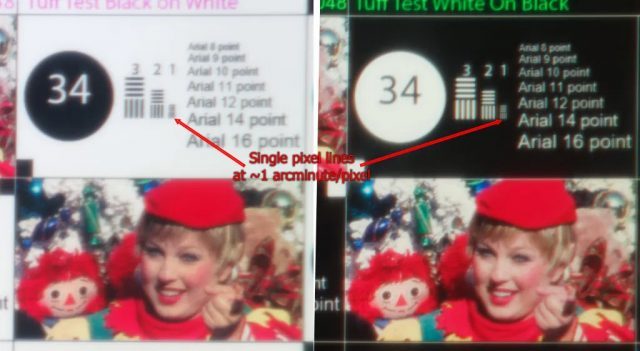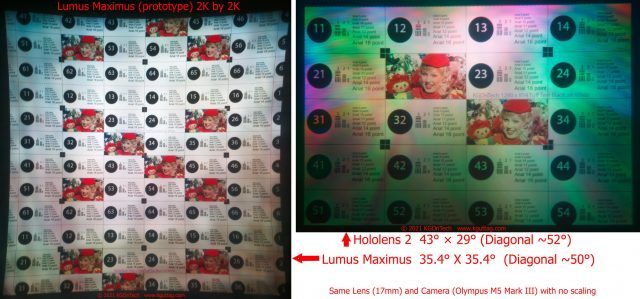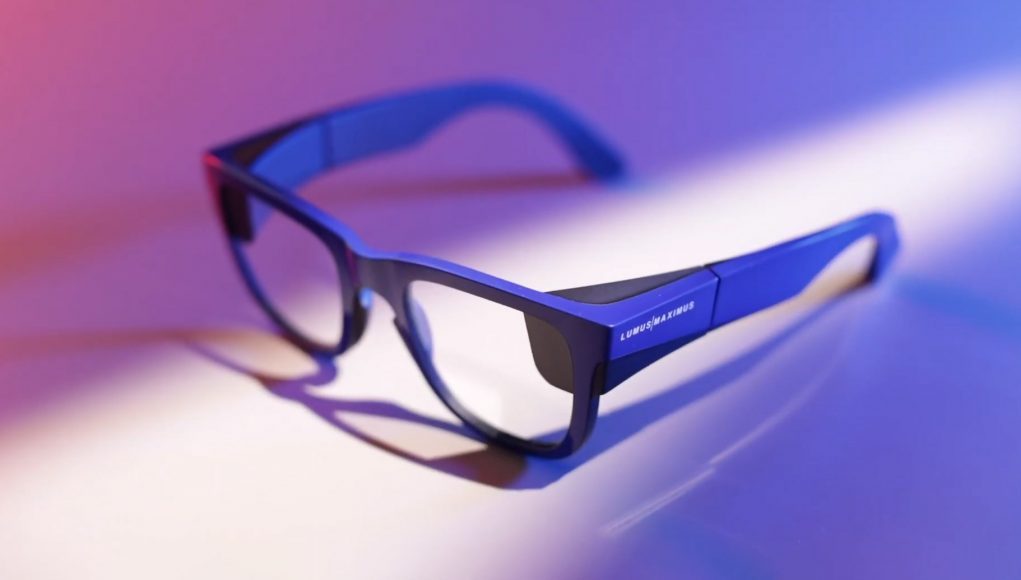Waveguide optics are increasingly looking like the best near-term solution for creating AR glasses that are truly glasses-sized. Lumus is one such waveguide company and recently let their latest waveguide prototype, the 50° FOV ‘Maximus’, be examined under the proverbial microscope. Through-the-lens photos of Lumus Maximus reveal impressive ‘retina’ resolution of 60 PPD, along with excellent brightness and leading image uniformity.
Lumus is one of a handful of companies building waveguides, but their approach is unlike most. Rather than diffractive waveguides, the company builds reflective waveguides which bring some advantages, especially in light efficiency, which means greater brightness (important for outdoor use) and more transparent lenses (important for being able to look like ‘normal’ glasses rather than darkened sunglasses).
Near-eye display expert Karl Guttag got to examine the Lumus Maximus waveguide up close, including getting permission to take through-the-lens photos with known test patterns for measuring effective resolution. Guttag came away impressed with the performance of the Maximus waveguide across a range of metrics, though he notes that it’s yet to be proven whether or not the company’s manufacturing method is scalable.

The Lumus Maximus prototype that Guttag examined was merely a head-mounted display built to show off the waveguide; it doesn’t currently include any of the on-board compute, sensors, or batteries that would still need to be packed into the glasses to make them proper standalone AR glasses—as DigiLens has done with its Design v1. Still, the Maximus was functional from a display standpoint, allowing for a detailed look at real-world visual performance.
Effective Resolution
The current prototype uses a 2,048 × 2,048 LCOS microdisplay (per-eye) and spreads those pixels across a 50° diagonal field-of-view. Even with all those pixels you could wind up with poor image quality if you can’t precisely control the light as it makes its way from the display, through the optics, and into the user’s eye.
The Lumus Maximus waveguide seems to do great job of preserving the display clarity, even after all the bouncing necessary to expand the image from the tiny microdisplay to the full 50° field-of-view.

Guttag found that the Maximus waveguide managed an angular resolution of 60 pixels per-degree at the center of the display, which meets the ‘retina resolution’ bar. In theory, that means if you were holding an augmented reality book in front of you at a normal distance, you’d easily be able to make out the letters on the page (assuming the image processing pipeline applied during head tracking doesn’t sacrifice any clarity).
For comparison, no consumer VR headset on the market has achieved 60 pixels per-degree, not even the upcoming Vive Pro 2 with its class-leading 2,448 × 2,448 resolution. This is because VR headsets spread their resolution out over a much larger area, which trades angular resolution in favor of a wider field-of-view.
Brightness
Brightness is hugely important in AR glasses because many use-cases are imagined to happen on-the-go, which includes outdoors during sunny days. If you don’t have enough brightness, users will hardly be able to see what’s shown in the glasses when the backdrop is bright. Many AR headsets struggle to achieve brightness that’s even sufficient for indoor usage, which is why they tend to tint the lenses like sunglasses.
As a reflective waveguide, brightness seems to be one of Lumus’ key advantages. Guttag reports that the company claims 3,000 nit brightness for the Maximus prototype. Equally important as the brightness of the resulting image is the efficiency of the entire optical pipeline. If your optical pipeline loses 90% of the light put into it, you can theoretically add a brighter light source to reach your desired output brightness—but this comes at the cost of more bulk, heat, and cost. Thus, a minimally bright light source combined with a highly efficient optical pipeline is ideal.

To that end, Lumus claims it expects Maximus will reach an efficiency of 650 nits per-lumen, which Guttag points out is more than ten times as efficient as the WaveOptics waveguide which sits at 50 nits per-lumen (which is why we aren’t surprised to see the new Snap AR glasses with a dark sunglasses tint). Not all diffractive waveguides may be as inefficient as WaveOptics however; in our recent hands-on with DigiLens’ latest (diffractive) waveguides, the company said they’ve reached 300 nits per-lumen.
Image Uniformity
The Lumus Maximus prototype also shows impressive image uniformity, which is the consistency of brightness, color, and resolution across the display (colloquially called the ‘sweet spot’ in the VR space).

Above we can see a comparison between Maximus and HoloLens 2, the latter of which has long suffered from poor color uniformity, causing a rainbow-like haze over the view. While HoloLens 2 is a worse-case example for comparison, Maximus still appears to be ahead of others as well. “The color and brightness uniformity of the image, while not perfect, is vastly better than any other waveguide-type optics I have seen,” says Guttag.
Granted, there’s still room for improvement. While the Maximus above clearly looks better than HoloLens 2, you can still clearly see the color uniformity and brightness start to fall off at the corners of the Maximus image. While this wouldn’t be as much of an issue with an immersive field-of-view, recall the image here is only 50° diagonally, which means the corners of the image are not far into the peripheral view where poor uniformity would be less noticable.
– – — – –
For all of its impressive optical performance, a huge question remains at this stage in the development of consumer AR glasses: can Lumus’ reflective waveguides affordably scale to large manufacturing volumes?

Last year Lumus announced a strategic partnership with glass specialty company Schott to grow manufacturing capacity and achieve what the companies call “favourable costs.” Guttag figures that Lumus’ approach could be “at least as cost-effective as diffractive waveguides” given the appropriate investment in manufacturing.
For an even more detailed analysis of the Lumus Maximus prototype, check out Guttag’s complete article.







